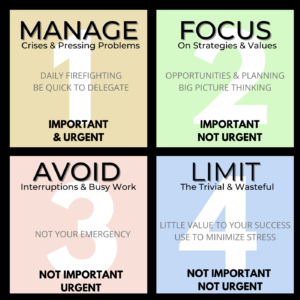
9/23/2016
Do you feel like you run from one emergency to another? Does your To Do list get shoved aside as your day suddenly fills up with tasks? Do you wonder where your time disappears to, or do you end your day feeling like you didn’t really didn’t accomplish anything? Have you ever watched with envy as your competitor moves calmly through their day? Why do some people get so much accomplished while others seem to run around putting out fires?
If you find yourself with too many emergencies and not enough time to deal with them, learn from Stephen Covey and his time matrix.
Everything you do is not equally important to your success
Prioritizing all tasks is at the heart of his simple system. Covey’s system makes use of four different quadrants that allow you to prioritize tasks in relation to their importance and urgency to YOU as a leader. This helps you to decide whether you need to address a task immediately, postpone it, delegate it, or eliminate it altogether.
Only after getting unimportant tasks off your plate can you look at the really important things that will propel your business forward, and focus on things that mesh with your talents, intersts, and core duties as a CEO and leader. Currenly you may be doing important things that other people in your business are capable of doing. These tasks, while essential, take you away from your main priorities of leadership.
Do What Matters Most
Business management experts such as Stephen Covey long ago realized that managing time is a defining factor to business success, so he created a time matrix. The matrix visually shows what tasks truly need your attention and will move your company forward.
It isn't so much a system of 'start doing' but rather a system of creating a 'stop doing' list.
The Covey Matrix
The time management matrix is separated into four quadrants that are organized by importance and urgency. Important responsibilities contribute to your success and the success of your business. Urgent responsibilities need your immediate attention. These activities are often tied to daily operations.
Divide your tasks into quadrants

Quadrant 1 – Important deadlines with high urgency. These need your immediate attention and cannot be delayed.
- Crises
- Projects with deadlines
- Emergencies
- Last minute changes and preparation
Quadrant 2 – Long term planning and strategy.
- Planning
- Strategic Planning
- Training, Developing and Mentoring
- Researching new methods of business and production
- Finance and records analysis
- Building key relationships with people who can help your business: landlords, bankers, accountants, etc.
- Continuing education
- Peer Advisory Groups
Quadrant 3 – Distractions that are urgent but not very important.
These activities may even be enjoyable but don’t move you any closer to your goals.
- Interrruptions
- Sitting on boards that don't bring value to your business
- Dealing with minor details your team could handle without your input
- Running errands, data entry, or other low level tasks better left to employees
Quadrant 4 – Activities with little to no value to your long or short term success.
- Time wasters, including pleasant people who love to chat
- TV, internet, and other eye candy
- Long lunches
Each day put all of your 'to dos' in one of the quadrants.
Over time you will most likely see a trend. It is very common to see a large number of items in #1 and #3. If you do, is it any wonder why you feel stressed out? Most of your tasks are considered urgent even if they are not all that important.
You need to deal with Quadrant 1 items because they are crucial and time-sensitive.
Build a team with systems around you to limit the number of items in Quadrant 1, and maybe spend more time in Quadrant 2 planning a smoother execution.
QUADRANT 2
Look to spend approximately 20% of your time in the Quadrant 2 area - The Important Planning & Strategy Quadrant.
This will allow you time to plan, analyze, and build the business structure that will eliminate many of the emergencies in Quadrant 1. This area is often neglected because, while important, there is no emergency to draw your attention to it. It is easy to procrastinate and not deal with the tasks in Quadrant 2, yet they hold the key to your future success.
QUADRANT 3
You may find that many of the tasks in Quadrant 3 can be delegated to another person in the company or hired out.
I often see successful entrepreneurs going to the post office, performing routine filing, and data entry. If you can't eliminate, delegate these tasks to others, or become more efficient at doing them, then look at postponing these until Quadrant 2 items are done.
